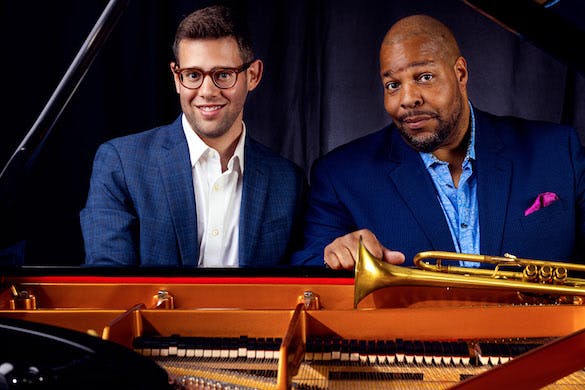Despite the Generation Gap, All Jazz Bases Are Covered
Pianist Steven Feifke and trumpeter Bijon Watson start their group’s self-titled first album with a variation of ‘I Got Rhythm’ and end with the ever-lovin’ blues.

Steven Feifke/Bijon Watson
‘Generation Gap Jazz Orchestra’ (Cellar Live Records)
For a jazz composer and/or arranger, George Gershwin’s iconic chord changes to “I Got Rhythm” are an immediate link with tradition. Pianist Steven Feifke and trumpeter Bijon Watson are well aware of this, which is why they make their own hard-charging “Rhythm” variation the opening track of their new album, the self-titled first release by “The Generation Gap Jazz Orchestra.”
For the same reason, their variation — which they have titled, with a rather droll nod to our contemporary, largely digital existence, “I Got Algorithm” — was the climactic number on their record launch concert at Birdland on Sunday evening.
The group’s name derives from the comparative ages of the two co-leaders, in that Mr. Feifke is at least a generation younger than Mr. Watson. The other players range from their 20s to their 60s; at least one of Mr. Feifke’s instructors and mentors, saxophonist Dave Pietro, was featured in the reed section.
Most of the generations the orchestra covers are relatively recent: The sounds generally have a post-1970 feel to them, out of the contemporary big-band tradition of Buddy Rich, John Clayton and Jeff Hamilton, Thad Jones and Mel Lewis, and all of the arrangers for the Village Vanguard Jazz Orchestra.
The major exception is, in fact, the “Rhythm” variation, which provides a continuity going back to 1930, when George and Ira Gershwin created the tune that would grow up to be the ultimate jazz anthem. Mr. Feifke’s “I Got Algorithm” is a direct descendent of Duke Ellington’s “Cottontail,” Count Basie’s “Basie” (composed for him by Ernie Wilkins), Woody Herman’s “Apple Honey” and “Northwest Passage,” Billy Eckstine’s “Rhythm in a Riff,” and, more recently, Clayton and Hamilton’s explosive big band treatment of Sonny Stitt’s “Eternal Triangle.” Those are just a few of the better-known big band variations — and not even counting the theme to “The Flintstones.”
In addition to a new construction on top of jazz’s most favored foundation, the set features several jazz standards, among them Joe Henderson’s 1964 “Inner Urge,” which was set up as a clash of contrasts between the highest and lowest members of the reed section, Mr. Pietro on alto (at Birdland, anyhow; Alexa Tarantino plays on the album) and Lauren Sevian on baritone sax — and she’s playing the low-A baritone, which dives even deeper than virtually any other horn.
Special guest Kurt Elling takes over on two songs, one of which, “Sassy” is a funky, hip-hop-ish original that he also sings in very different form on his own current album, “Superblue.” “Until” is a minor-key waltz that Sting wrote as a love theme for the 2001 “Kate and Leopold,” thus living up to the time-honored tradition of memorable music from forgettable films.
The orchestra starts with a dissonant, somewhat menacing intro before Will Brahm’s guitar and then Mr. Elling introduce the 3/4-time melody. At Birdland, singer Christian Wiggs stood in for Mr. Elling on “Until” as well as a stylish chart of the 1929 “I’m Confessin’.” On “Until” especially, I could tell his phrasing followed Mr. Elling’s, but I couldn’t quite make out the timbre of his voice from where I was sitting — somewhere between the bari sax and the bass trombone — in the packed house.
The orchestra also essayed several Feifke originals, among them “Kinetic” (from a previous album by the pianist) and “Scenes From My Dreams,” which was bouncy rather than dreamy, and in general sounded like something that would have been perfect for Doc Severinson and the Tonight Show Orchestra 50 years ago. (Yes, that’s a compliment.)
Messrs. Feifke and Watson have enough respect for tradition to begin with “Rhythm” and end the album with the ever-lovin’ blues. In this case it’s Mr. Feifke’s “Blues in a Second,” in which all five trumpeters, including guest Sean Jones, go after it in an epic brass battle that made me think of Mary Lou Williams and Duke Ellington’s “Trumpets No End.”
Along the way, they treated us to an inspired big band treatment of “Dollar’s Moods” by a pivotal South African group, The Jazz Epistles, and again it was bouncy rather than moody. The other standard was Horace Silver’s minor-key “Nica’s Dream,” one of many jazz classics dedicated to one of music’s great patrons, the “Baroness,” Pannonica de Koenigswarter, along with Gigi Gryce’s “Nica’s Tempo” and Thelonious Monk’s “Pannonica.”
Upon hearing this lively and inspired big band interpretation, I couldn’t help but reflect that even though I was hardly the oldest person in the room at Birdland, I was quite possibly the only one present who had actually had the privilege of meeting the baroness herself. Yeah, I guess it’s a generational thing.

